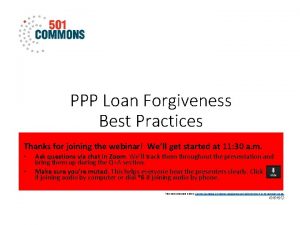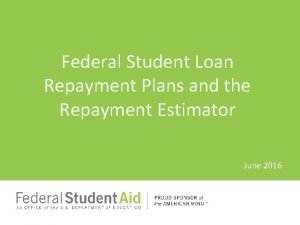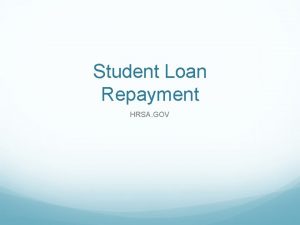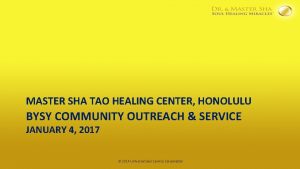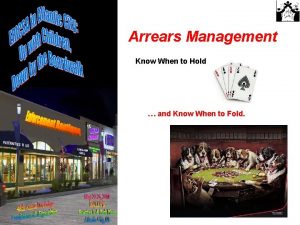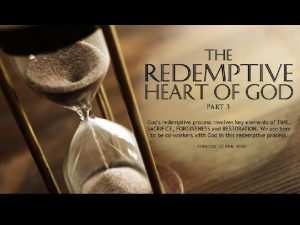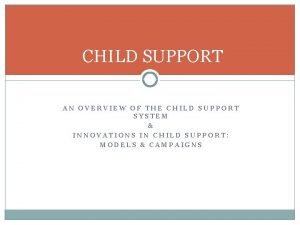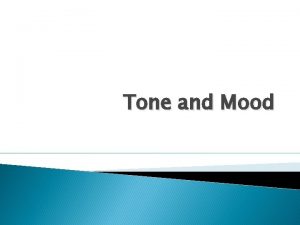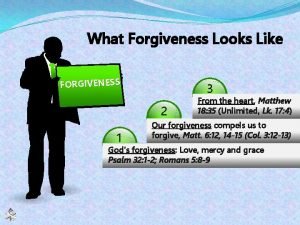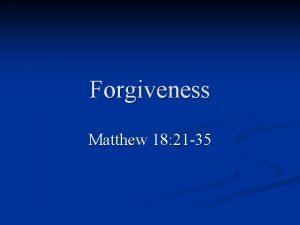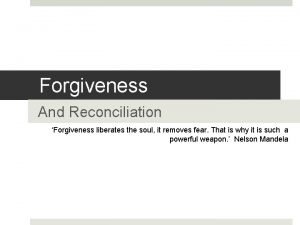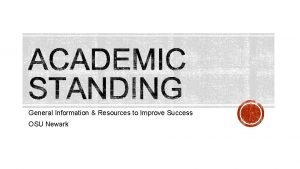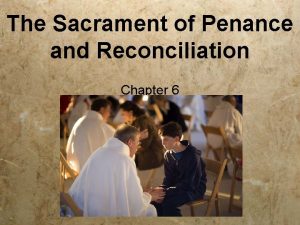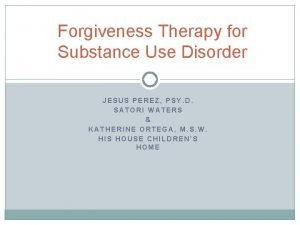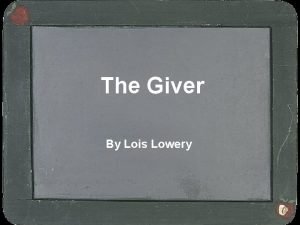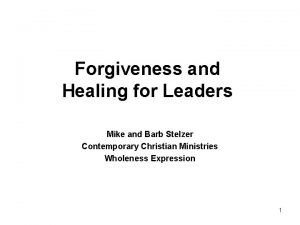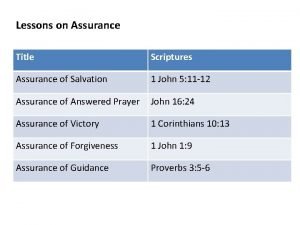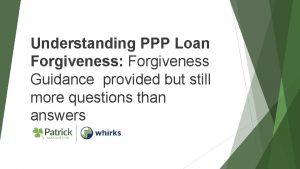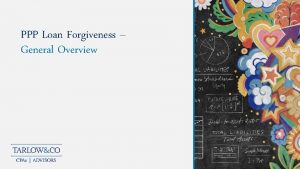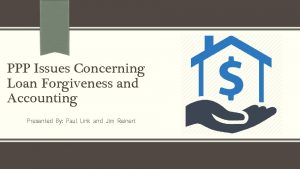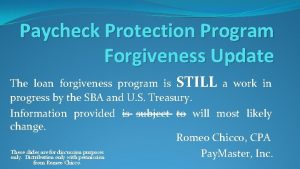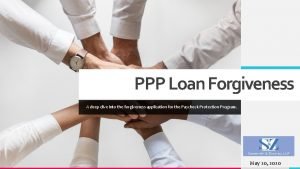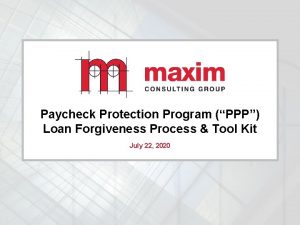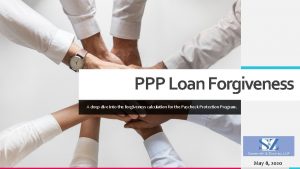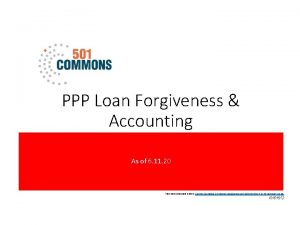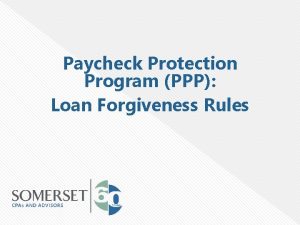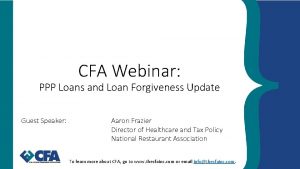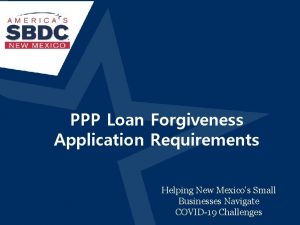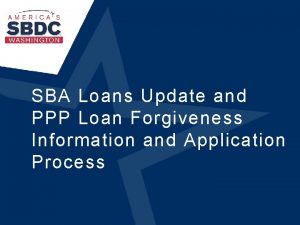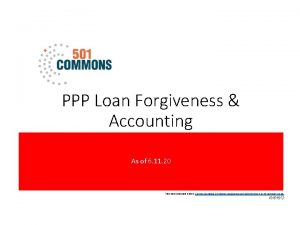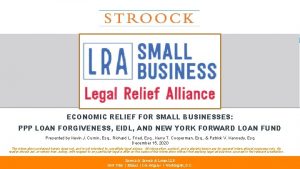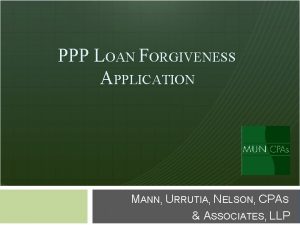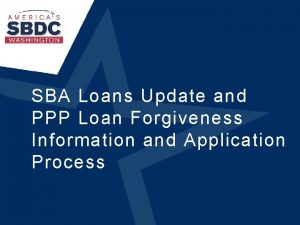How to Prepare for PPP Loan Forgiveness Presented















































- Slides: 47

How to Prepare for PPP Loan Forgiveness Presented by PCSB Bank MODERATOR Joseph Roberto, PCSB Bank PANELISTS Mike Goldrick & Dominick Petramale, PCSB Bank Ron De. Soiza, PKF O’Connor Davies Tom Baylis & Chris Palmer, Cullen | Dykman June 22, 2020

Today’s Agenda § Ready, Shoot, Aim! § PPP Application Overview § Payroll Costs § Full-Time Equivalent Employees (FTEs) § Nonpayroll Costs § Documentation Requirements § Key Takeaways and Recommended Actions § Tools and Services Available 2

Color Coding § Blue – Rules existing prior to the Flexibility Act § Green – Rules added or changed by or subsequent to the Flexibility Act § Red – Questions / ambiguities 3

The Application

Ready, Shoot, Aim! § Application released Friday night, May 15 th § Updated and reissued June 17 th, including an EZ version § PPP Flexibility Act of 2020 enacted on June 5 th § The now obsolete loan forgiveness application answered some questions to help businesses plan and prepare § But many questions remain and new questions have arisen § Despite the new law, the basic application and underlying principles are likely to remain substantially the same 5

Dates § PPP Program Approvals started • Round 1 -Early April • Round 2 -Late April § Assuming an April 13 th funding date • 8 -week period ends June 5 th • 24 -week period ends September 25 th § Many banks no longer taking new applications 6

Dates § Lender has 60 days to review application forgiveness and submit to SBA § SBA has 90 days to review and render decision to review or not review. 7

The Basic Loan Forgiveness Calculation Eligible Costs Incurred Less: Salary/Hourly Wage Reductions Adjusted Eligible Costs X FTE Reduction Quotient Total Forgiveness Amount* Less: EIDL Grant PPP Forgiveness Amount * Not to exceed 166. 6% of Payroll Costs or 100% of the PPP Loan 8

More Basics Loan Forgiveness – Eligible Amount § Costs incurred and payments made for the following costs during the 24 -week (or 8 -week) forgiveness period (the Covered Period or Alternative Payroll Covered Period): • Payroll costs • Payments of interest on mortgage indebtedness outstanding prior to February 15, 2020 • Payments of rent and utilities § At least 60% must be expended on payroll costs. 9

Application Overview-3 Parts § PPP Loan Forgiveness Calculation Form § PPP Schedule A Worksheet § Due date – No later than 10 months after the end of Borrower’s Covered Period 10

Loan Forgiveness Calculation Form § Payroll Costs (salaries, paid vacation, parental, family, medical, sick leave, health, retirement. Also self employment subject to limits, SUI, MTA. ) § Nonpayroll Costs (Mortgage interest, rent/leases, utilities) § Adjustments for FTE & Salary/Hourly Wage Reductions § Potential Forgiveness Amount § Borrower Certifications 11

Page 2 - Certifications § Funds were used for: • Eligible costs • Includes all applicable reductions in salaries and FTEs • Does not include non-payroll costs in excess of 40% • Limits owner’s compensation to the lesser of 8/52 nds of 2019 compensation or $15, 385 (8 -weeks) or the lesser of 2. 5/12 ths of 2019 compensation or $20, 833 (24 -weeks) § If knowingly used for unauthorized purposes, may be subject to federal civil and/or criminal penalties § All required documentation is submitted with application § Tax documents are authentic § SBA may request additional information; failure to provide will result in denial of forgiveness 12

Schedule A § Summarizes cash compensation, separately for: • • • Employees earning $100, 000 or less Employees earning > $100, 000 Owners § Summarizes all non-cash compensation (benefits and taxes) 13

Schedule A (continued) § Sums all payroll costs (flows to main form) § Calculates the FTE Reduction Quotient (flows to main form) 14

PPP Schedule A Worksheet § Supports Calculation of Eligible Cash Compensation and salary/hourly wage reductions • Every employee paid during period must be listed with last 4 of SS# § Two Parts to the Worksheet • Table 1 -For employees not > $100, 000 in 2019 • Table 2 -For employees > $100, 000 in 2019 § Instructions contain guidance for: • Computing average FTEs • Computing Salary/Hourly Wage Reductions • Determining FTE reduction exceptions and safe harbors 15

Schedule A – Table 1 16

Schedule A – Table 2 17

Determining Payroll Costs. PPP Schedule A Worksheet-Table 1 and Table 2 § Include payroll costs paid and payroll costs incurred during the Covered Period (or Alternative Payroll Covered Period) • Payroll costs are considered to be paid on the day checks distributed/ACH Credit • Payroll costs are considered incurred on the day employee pay earned • Payroll costs incurred but not paid before end of covered period are eligible if paid onbefore next regular payroll date What does this mean? 18

Payroll Costs (continued) § Alternative Payroll Covered Period (APCP) • Borrowers with biweekly (or more frequent) may elect the 24 -week (or 8 -week) period starting with first payroll after loan funding date. • APCP cannot be used for non payroll costs § Salaries of Owner-Employees • Cannot exceed the lesser of 8/52 nds of 2019 compensation or $15, 385 (8 -weeks) or the lesser of 2. 5/12 ths of 2019 compensation or $20, 833 (24 -weeks) • Owner-employees now lumped with self-employed individuals and partners • Owner-employee is not defined − Family members? − Minimum equity percentage to qualify? 19

Payroll Costs – Many Questions Remain § Are payroll costs incurred prior to the CP, but paid during the CP permissible? (This could result in one or more additional payrolls being included in payroll costs. ) § Are non-salary costs also considered to be paid when paychecks are distributed and incurred on the day the pay is earned? • Are prior year retirement costs paid during the CP included? • What about health benefits for the CP paid prior to the CP? • Or prepaid health benefits? § Our advice - pay expenses in the ordinary course; business as usual 20

Payroll Costs – Example Is this what is intended? § Monthly payroll, distributed on the 5 th of the month following the period earned § PPP loan date is May 1 st § Covered period is May 1 st through June 25 th 21

Payroll Costs – Example Is this what is intended? § Monthly payroll, distributed on the 5 th of the month following the period earned § PPP loan date is May 1 st § Covered period is May 1 st through June 25 th 22

Full-Time Equivalent Employees (FTEs) § Must be determined for all base periods: • February 15, 2019 to June 30, 2019 • January 1, 2020 to February 29, 2020 • Optional for seasonal employers – any 12 -consecutive weeks between May 1, 2019 and September 15, 2019 § And for safe harbor calculations: • February 15, 2020 to April 26, 2020 • The date prior to December 31, 2020 (or June 30, 2020? ) that you have restored full employment 23

Determining FTE’s § Based on hours paid (as opposed to hours worked) § Calculated using a 40 -hour week • Average hours per week / 40, rounded to the nearest 10 th • Maximum for each employee is 1 FTE § What if your standard work week is less than 40 hours? § Alternative Simplified method • 1 for employees who work 40 hours or more • . 5 for all other employees § Owners are not included in the average FTE computations § Method chosen must be applied consistently for all FTE calculations 24

FTE Reduction Quotient § The FTE Reduction Quotient (bottom of Schedule A) is: • Average FTEs in your Covered Period (or APCP), divided by • Average FTEs in your chosen reference period (the base period with the lowest number of average FTEs) 25

FTE Reduction Exceptions § Borrower makes a good faith written offer to rehire a furloughed employee during the covered period or APCP which was rejected by the employee • Offer was at the same rate of pay earned during the last pay period prior to separation • Offer is rejected • Borrower has documentation and reports this within 30 days to state unemployment § Employees who during the Covered Period: • Are fired for cause • Voluntarily resign or reduce hours § Unable to rehire or replace individuals who were employees on February 15, 2020 26

FTE Reduction Safe Harbor. Page 8 of Instructions § Borrowers are exempt from reduction in forgiveness based on reductions in FTE’s if: • Borrower reduced FTE’s in period 2/15/20 – 4/26/20; and • FTE levels restored not later than 12/31/20 (6/30/20) to the FTE employee levels in pay period that included 2/15/20 § No guidance on how long restored FTE’s have to be maintained – right now this is a point in time test § Employees hired to restore the FTE’s do not have to be the same as the ones let go. 27

Salary/Hourly Wage Reductions. PPP Schedule A Worksheet-Table 1 § Complex calculation that (fortunately) only applies to: • Employees who earned an annualized rate of pay of not more than $100, 000 for any pay period in 2019 • Whose salaries were reduced by more than 25% during the Covered Period (or Alternative Payroll Covered Period) as compared to Q 1 -20 § If this applies, the amount of loan forgiveness is reduced by the amount by which the salary reduction exceeds 25%, unless: • The annual salary (or hourly rate) is restored by June 30, 2020 December 31, 2020, to the level in place as of February 15, 2020. 28

Nonpayroll Costs. Main Form Lines 2, 3, and 4 § Includes mortgage interest, rent, utilities • Agreements / services must have been in place prior to 2/15/20 • Must be paid during the covered period; or • Incurred during the covered period and paid on or before next regular billing date even if that is after the covered period § Mortgages and rents include real and personal property § Prepayments of mortgage interest explicitly disallowed § No such explicit prohibition against rent or utility prepayments 29

Nonpayroll Costs (continued) § Instructions and current guidance do not: • Prohibit payment of prior months non-payroll costs, or • Prohibit pre-payment of future non-payroll costs § But does this mean Borrowers can: • Prepay several months of rent or utilities (what about related party rents? ) • Several months of deferred rents? § Borrower can choose which non-payroll costs to include/exclude in the determination of forgivable costs • No such provision for payroll costs 30

New EZ Form § May be used if • Self-employed with no employees, or • Did not reduce salaries/wages by > 25% or number of employees or average paid hours between 1/1/20 and end of Covered Period (but ignore reductions after 2/15/20 due to inability to rehire and refusals to come back to work), or • Did not reduce salaries/wages by > 25% and unable to operate at pre -February 15, 2020 levels due to certain COVID-19 directives § Eliminates the need to compute and submit support for FTEs, but must maintain support to verify the above 31

Required Documents to be Submitted § PPP Loan Forgiveness Calculation Form § PPP Schedule A § Optional PPP Borrower Demographic Information Form § Payroll • Bank account statements or 3 rd party payroll service reports document the amount of cash compensation to employees • Tax forms: 941’s, state payroll tax returns • Payment receipts, cancelled checks, or account statements documenting the amount of employer contributions to employee health insurance and retirement plans included in the forgiveness amount 32

Required Documents to be Submitted § FTE documentation showing • Average number of FTE employees on payroll per month between 2/15/19 and 6/30/19, OR • Average number of FTE employees on payroll per month between 1/1/20 and 2/29/20, OR • Seasonal employer calculation • Must match PPP Schedule A, Line 11 33

Required Documents to be Submitted § Non-payroll costs • Mortgage interest - Amortization schedule, cancelled checks, account statements for February 2020 and covered period and 1 month after covered period • Lease payments – Copy of lease agreement, cancelled checks, lessor account statements for February 2020, the covered period, and 1 month after the covered period • Utility payments – Copy of invoices from February 2020, those paid during covered period, cancelled checks, and account statements verifying those eligible payments 34

Documents to be Maintained § Documentation supporting the listing of each individual employee in PPP Schedule A worksheet table 1 including applicable documentation of salary/hourly wage reduction calculation § Documentation supporting each employee listed on PPP Schedule A Worksheet Table 2 received during any single pay period in 2019 compensation at an annualized rate of more than $100, 000 § Documentation regarding any employee job offers and refusals, firings for cause, voluntary resignations, and written requests by employee for reduction in work schedule § Documentation supporting the PPP Schedule A worksheet “FTE Reduction Safe Harbor” 35

Documents to be Maintained § All Files must be maintained for six years after the date the loan is forgiven or repaid in full. § Must permit authorized representatives of SBA, including its Office of Inspector General, access to such files upon request. 36

Planning Considerations

Maximizing Forgiveness § Reducing FTEs has the biggest negative impact on loan forgiveness • It is better to reduce salaries than FTEs • If you reduced FTEs between 2/15 and 4/26, plan to rehire them by 12/31 If non-payroll expenses will fall short of the 40% cap, make sure you are picking up all eligible interest, rent and utility costs § Monitor new guidance as it comes out in order to maximize your health insurance, retirement costs, rent and utilities • Any limitations to prepayments? 38

Maximizing Forgiveness (continued) § It’s okay to pay bonuses or hazard pay premiums to employees (subject to overall cap on individual employee compensation) § Keep good records, starting now • Preparing a complete application and collecting and submitting all required documentation is the key to trouble-free forgiveness. • Maintaining complete and accurate files is the key to a trouble-free audit § Don’t do anything out of the ordinary course that might be considered abusive § And – if you haven’t done so – make sure you properly document your assessment of need 39

24 -Weeks or 8 -Weeks? § 8 -Weeks if: • You’ve expended all the funds and you are confident that all or most of the loan will be forgiven • You need or want to get the loan off your books as quickly as possible • You have concerns about continuing to support payroll / FTEs for the additional 16 -weeks. § Otherwise, 24 -weeks probably makes sense. § You don’t have to decide right away. • Rules are still changing. You can wait for more clarification before you decide. 40

More Changes on the Way § SBA guidance to • Clarify costs incurred and costs paid, especially with regard to non -cash payroll costs • Define the term owner-employee § Clarify filing date requirements – Can a Borrower apply before their 24 weeks is up? § Clarify documentation to support inability to rehire § Clarify unable to operate at pre-pandemic levels due to compliance with certain agency directives 41

Disclaimer This information and any presentation accompanying it has been prepared by PKF O’Connor Davies, LLP, Cullen and Dykman and PCSB Bank for informational purposes only, and is not intended as and should not be relied upon as legal advice or opinion, or as a substitute for the advice of counsel. You should not rely on, take action on or fail to take action, based on this information. 42

Panelist Contact Information 43

Joseph Roberto Chairman, President & CEO PCSB Bank Michael Goldrick EVP, Chief Lending Officer PCSB Bank Dominick Petramale SVP, Retail Banking Officer PCSB Bank jroberto@mypcsb. com mgoldrick@mypcsb. com dpetramale@mypcsb. com 44

Support Available from PKF O’Connor Davies § Free forgiveness calculator updated for new guidance § On-going thought leadership in our COVID-19 Resource Center § Forgiveness Application Preparation § Forgiveness Application Review § Consulting and advisory services 45 Ronald F. De. Soiza, CPA, ABV Partner 203. 434. 3927 rdesoiza@pkfod. com

Christopher H. Palmer Managing Partner Cullen and Dykman LLP Thomas S. Baylis Partner Cullen and Dykman LLP cpalmer@cullenllp. com tbaylis@cullenllp. com One of New York State’s Oldest Law Firms, Serving Clients Since 1850. 212. 732. 2000 | cullenllp. com 46

THANK YOU! 47
 Ppp loan forgiveness
Ppp loan forgiveness Nebraska teacher loan forgiveness
Nebraska teacher loan forgiveness Hrsa student loan forgiveness
Hrsa student loan forgiveness Ppp loan list of recipients 2021
Ppp loan list of recipients 2021 Fau university advising services
Fau university advising services Theme of forgiveness in long day's journey into night
Theme of forgiveness in long day's journey into night Master sha
Master sha Arrears management program
Arrears management program God's forgiveness
God's forgiveness Forgiveness vs reconciliation
Forgiveness vs reconciliation Joseph forgives his brothers lesson 17
Joseph forgives his brothers lesson 17 Child support arrears forgiveness letter missouri
Child support arrears forgiveness letter missouri Genesis chapter 45
Genesis chapter 45 Fgcu grade forgiveness
Fgcu grade forgiveness How to explain the tone of a story
How to explain the tone of a story What forgiveness looks like
What forgiveness looks like Principles of forgiveness of sin
Principles of forgiveness of sin The great gatsby setting
The great gatsby setting Questions about forgiveness
Questions about forgiveness I believe in the forgiveness of sins
I believe in the forgiveness of sins Forgiveness frees the soul
Forgiveness frees the soul Osu!
Osu! Chapter 6 sin and forgiveness answers
Chapter 6 sin and forgiveness answers Ted talk on forgiveness
Ted talk on forgiveness Everyone needs forgiveness the kindness of a savior
Everyone needs forgiveness the kindness of a savior Phases of forgiveness
Phases of forgiveness Why does the giver ask jonas for forgiveness
Why does the giver ask jonas for forgiveness What is forgiveness
What is forgiveness Scriptures on forgiveness
Scriptures on forgiveness Dr robert enright
Dr robert enright Matthew 6 14
Matthew 6 14 What is to forgive
What is to forgive Lessons on assurance
Lessons on assurance Vätsketryck formel
Vätsketryck formel Tallinjen
Tallinjen Särskild löneskatt för pensionskostnader
Särskild löneskatt för pensionskostnader Elektronik för barn
Elektronik för barn Borra hål för knoppar
Borra hål för knoppar Smärtskolan kunskap för livet
Smärtskolan kunskap för livet Shaktismen
Shaktismen Argument för teckenspråk som minoritetsspråk
Argument för teckenspråk som minoritetsspråk Omprov cellprov
Omprov cellprov Autokratiskt ledarskap
Autokratiskt ledarskap Ellika andolf
Ellika andolf Datorkunskap för nybörjare
Datorkunskap för nybörjare Rita perspektiv
Rita perspektiv Toppslätskivling effekt
Toppslätskivling effekt Vad står k.r.å.k.a.n för
Vad står k.r.å.k.a.n för
